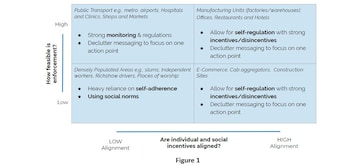
The ever increasing threat of COVID-19 has resulted in several guidelines being disseminated to the public. As India adapts to the “new normal”, these policies will need to become more contextual, allowing for disparate rule-making across social scenarios. Use of simple behavioural principles can help creators of these guidelines—political leaders, government officials, business owners, etc—to not only craft these enforcement mechanisms but also communicate them.
Individuals have a limited ‘mental bandwidth’—they can make decisions for only a limited number of issues at a time. Sendhil Mullainathan and Eldar Shafir call this limitation a ‘scarcity’ where the occupation of our brain with other concerns affects our abilities to make rational decisions. Multiple reasons, like financial stress, can cause scarcity. In an article published in 2013, Mullainathan and Shafir, along with Anandi Mani and Jiaying Zhao, show that farmers in India perform much better in IQ tests after harvests, when they have money in hand, compared to before harvests when money is tighter.
These insights are key to informing how we develop public messaging around COVID-19, especially in the current scenario where financial and health stress is coupled with a deluge of information on COVID-19. We propose that a suitable method of applying these insights is focusing the messaging on just one feasible and effective “to-do” in the given context. For example, messaging on social distancing in Dharavi (where nearly a million people are squeezed in an area of 2 square kilometers) could be perceived as noise, potentially devaluing information about other protective behaviours. Policymakers instead need to concentrate messaging around the most feasible protective behaviour in this context—mask-wearing.
In terms of creating the right enforcement strategy for the uptake of protective behaviours, we propose an easy framework policy creators could use. Try to broadly answer two key questions:
1. Do people have the underlying motivation to comply with protective behaviours?
2. Do we have the ability to monitor and regulate protective behaviours to ensure their compliance?
The first question attempts to break down behaviour on the side of the individual—what is the pressing thought in the individual’s brain in this context? Anticipating these motivations is crucial to making the best use of Mullainathan and Shafir’s advice. Does the individual’s contextual need to align with the society’s motivation (i.e. protection of all against COVID-19) at large? For example, individuals queuing up for public transport are more worried about reaching their homes or workplaces and less occupied by following social distancing rules at that moment. On the other hand, employees in service industries are heavily incentivised to follow best behaviours since an outbreak in the workplace could shut the whole facility down.
The second question in the framework deals with the variance in the capability of the institution to implement monitoring and enforcement mechanisms. For example, hospitals have strict rules about personnel movement on-premises and can allocate staff for monitoring purposes. Similarly, private institutions such as offices and hotels have the capability to regulate behaviours inside their premises, of both employees and customers. In contrast, it is implausible to expect any authority to actively monitor or enforce behaviour in densely packed housing, public transport, or say, private social gatherings.
The intersection of these two parameters of an individual’s underlying motivation and the institution’s capacity to regulate could be a handy heuristic in defining response strategies:
In the first case, where individuals’ needs are aligned with the compliance of protective behaviours, the focus should be on self-regulation. For instance, since private-sector employees are strongly incentivized to follow protective behaviour, we should rely on providing simple nudges that support self-regulation, with minimal monitoring systems, freeing up precious resources that can be used to prevent other means of infection, for example, in arranging transportation for employees from home to the workplace.
In the second case, where individual and societal motivations are less likely to align, the capability of institutions to enforce becomes important. Where it is feasible to monitor & regulate (like airports and hospitals), we should have strong regulations in the form of strict rules, fines and penalties to compensate for the gap in individual motivations to comply.
Where the institutions' capacity to monitor is low, seeding the protective behaviours as social norms, practicing social sanctioning and building collective responsibility for calling out violators of protective behaviours could help solve for the low motivation at an individual level and low ability to enforce at the institution level.
A one-size-fits-all approach risks spreading our already scarce resources thin while being counter-productive to ensuring widespread compliance. Instead, let’s focus on using the stick where it’s effective while nudging in other areas, and trusting our citizens to take care of themselves and others.
Figure 1 provides a visual representation of this framework.

—The article has been co-authored by Diksha Radhakrishnan
, Deputy Director, Centre for Social and Behaviour Change; Tirtha Patel, Assistant Manager, Centre for Social and Behaviour Change; and Shardul Vaidya, Lab Manager, Centre for Social and Behaviour Change. The views expressed are personal
(Edited by : Ajay Vaishnav)
First Published: Dec 18, 2020 5:17 PM IST
Check out our in-depth Market Coverage, Business News & get real-time Stock Market Updates on CNBC-TV18. Also, Watch our channels CNBC-TV18, CNBC Awaaz and CNBC Bajar Live on-the-go!


Andhra Pradesh Lok Sabha elections: A look at YSRCP candidates
Apr 25, 2024 6:54 PM
Lok Sabha elections 2024: Banks and schools to remain closed in these cities for phase 2 voting
Apr 25, 2024 5:33 PM
Andhra Pradesh Lok Sabha elections: Seats, schedule, NDA candidates and more
Apr 25, 2024 5:16 PM

